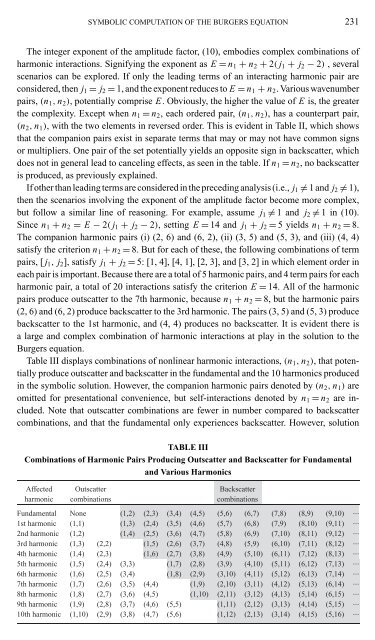A Preliminary Study of the Burgers Equation with Symbolic ...
A Preliminary Study of the Burgers Equation with Symbolic ...
A Preliminary Study of the Burgers Equation with Symbolic ...
You also want an ePaper? Increase the reach of your titles
YUMPU automatically turns print PDFs into web optimized ePapers that Google loves.
SYMBOLIC COMPUTATION OF THE BURGERS EQUATION 231<br />
The integer exponent <strong>of</strong> <strong>the</strong> amplitude factor, (10), embodies complex combinations <strong>of</strong><br />
harmonic interactions. Signifying <strong>the</strong> exponent as E = n1 + n2 + 2( j1 + j2 − 2) , several<br />
scenarios can be explored. If only <strong>the</strong> leading terms <strong>of</strong> an interacting harmonic pair are<br />
considered, <strong>the</strong>n j1 = j2 = 1, and <strong>the</strong> exponent reduces to E = n1 + n2. Various wavenumber<br />
pairs, (n1, n2), potentially comprise E. Obviously, <strong>the</strong> higher <strong>the</strong> value <strong>of</strong> E is, <strong>the</strong> greater<br />
<strong>the</strong> complexity. Except when n1 = n2, each ordered pair, (n1, n2), has a counterpart pair,<br />
(n2, n1), <strong>with</strong> <strong>the</strong> two elements in reversed order. This is evident in Table II, which shows<br />
that <strong>the</strong> companion pairs exist in separate terms that may or may not have common signs<br />
or multipliers. One pair <strong>of</strong> <strong>the</strong> set potentially yields an opposite sign in backscatter, which<br />
does not in general lead to canceling effects, as seen in <strong>the</strong> table. If n1 = n2, no backscatter<br />
is produced, as previously explained.<br />
If o<strong>the</strong>r than leading terms are considered in <strong>the</strong> preceding analysis (i.e., j1 = 1 and j2 = 1),<br />
<strong>the</strong>n <strong>the</strong> scenarios involving <strong>the</strong> exponent <strong>of</strong> <strong>the</strong> amplitude factor become more complex,<br />
but follow a similar line <strong>of</strong> reasoning. For example, assume j1 = 1 and j2 = 1 in (10).<br />
Since n1 + n2 = E − 2( j1 + j2 − 2), setting E = 14 and j1 + j2 = 5 yields n1 + n2 = 8.<br />
The companion harmonic pairs (i) (2, 6) and (6, 2), (ii) (3, 5) and (5, 3), and (iii) (4, 4)<br />
satisfy <strong>the</strong> criterion n1 + n2 = 8. But for each <strong>of</strong> <strong>the</strong>se, <strong>the</strong> following combinations <strong>of</strong> term<br />
pairs, [ j1, j2], satisfy j1 + j2 = 5: [1, 4], [4, 1], [2, 3], and [3, 2] in which element order in<br />
each pair is important. Because <strong>the</strong>re are a total <strong>of</strong> 5 harmonic pairs, and 4 term pairs for each<br />
harmonic pair, a total <strong>of</strong> 20 interactions satisfy <strong>the</strong> criterion E = 14. All <strong>of</strong> <strong>the</strong> harmonic<br />
pairs produce outscatter to <strong>the</strong> 7th harmonic, because n1 + n2 = 8, but <strong>the</strong> harmonic pairs<br />
(2, 6) and (6, 2) produce backscatter to <strong>the</strong> 3rd harmonic. The pairs (3, 5) and (5, 3) produce<br />
backscatter to <strong>the</strong> 1st harmonic, and (4, 4) produces no backscatter. It is evident <strong>the</strong>re is<br />
a large and complex combination <strong>of</strong> harmonic interactions at play in <strong>the</strong> solution to <strong>the</strong><br />
<strong>Burgers</strong> equation.<br />
Table III displays combinations <strong>of</strong> nonlinear harmonic interactions, (n1, n2), that potentially<br />
produce outscatter and backscatter in <strong>the</strong> fundamental and <strong>the</strong> 10 harmonics produced<br />
in <strong>the</strong> symbolic solution. However, <strong>the</strong> companion harmonic pairs denoted by (n2, n1) are<br />
omitted for presentational convenience, but self-interactions denoted by n1 = n2 are included.<br />
Note that outscatter combinations are fewer in number compared to backscatter<br />
combinations, and that <strong>the</strong> fundamental only experiences backscatter. However, solution<br />
TABLE III<br />
Combinations <strong>of</strong> Harmonic Pairs Producing Outscatter and Backscatter for Fundamental<br />
and Various Harmonics<br />
Affected Outscatter Backscatter<br />
harmonic combinations combinations<br />
Fundamental None (1,2) (2,3) (3,4) (4,5) (5,6) (6,7) (7,8) (8,9) (9,10) ...<br />
1st harmonic (1,1) (1,3) (2,4) (3,5) (4,6) (5,7) (6,8) (7,9) (8,10) (9,11) ...<br />
2nd harmonic (1,2) (1,4) (2,5) (3,6) (4,7) (5,8) (6,9) (7,10) (8,11) (9,12) ...<br />
3rd harmonic (1,3) (2,2) (1,5) (2,6) (3,7) (4,8) (5,9) (6,10) (7,11) (8,12) ...<br />
4th harmonic (1,4) (2,3) (1,6) (2,7) (3,8) (4,9) (5,10) (6,11) (7,12) (8,13) ...<br />
5th harmonic (1,5) (2,4) (3,3) (1,7) (2,8) (3,9) (4,10) (5,11) (6,12) (7,13) ...<br />
6th harmonic (1,6) (2,5) (3,4) (1,8) (2,9) (3,10) (4,11) (5,12) (6,13) (7,14) ...<br />
7th harmonic (1,7) (2,6) (3,5) (4,4) (1,9) (2,10) (3,11) (4,12) (5,13) (6,14) ...<br />
8th harmonic (1,8) (2,7) (3,6) (4,5) (1,10) (2,11) (3,12) (4,13) (5,14) (6,15) ...<br />
9th harmonic (1,9) (2,8) (3,7) (4,6) (5,5) (1,11) (2,12) (3,13) (4,14) (5,15) ...<br />
10th harmonic (1,10) (2,9) (3,8) (4,7) (5,6) (1,12) (2,13) (3,14) (4,15) (5,16) ...














